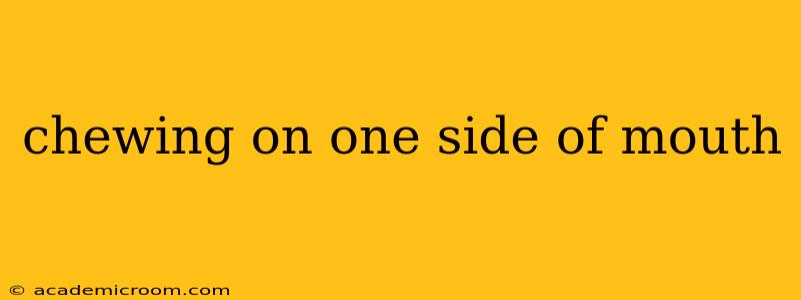Chewing predominantly on one side of your mouth is a common habit many people experience. While it might seem innocuous, persistently chewing on one side can lead to several oral health issues. This comprehensive guide explores the reasons behind this habit, potential consequences, and effective ways to address it.
Why Do I Chew on One Side of My Mouth?
This seemingly simple question encompasses a wide array of possible answers. Let's delve into the most frequent causes:
1. Existing Dental Issues:
Pain or discomfort in teeth, gums, or jaw joints on one side of the mouth can naturally lead to a preference for chewing on the other side. This could stem from:
- TMJ (Temporomandibular Joint) Disorder: TMJ problems often cause jaw pain and limited movement, making chewing on the affected side difficult or painful.
- Dental Fillings, Crowns, or Bridges: Poorly fitted restorations can create discomfort during chewing, leading to avoidance of that side.
- Tooth Decay or Abscesses: Infected or damaged teeth are understandably avoided during chewing.
- Gingivitis or Periodontitis: Inflamed or infected gums can make chewing painful.
2. Habit and Learned Behavior:
Sometimes, chewing on one side becomes a learned habit, formed early in life and ingrained over time. This can occur without any underlying dental issues.
3. Muscle Imbalance:
Over time, consistently chewing on one side can lead to muscle imbalances in the jaw and facial muscles. This imbalance might further reinforce the habit.
4. Neurological Conditions:
In rare cases, neurological conditions can affect chewing patterns, potentially causing a preference for one side.
What are the Potential Problems of Chewing on One Side?
Persistently chewing on only one side of your mouth can have several detrimental effects on your oral health:
- Uneven Jaw Muscle Development: This can lead to facial asymmetry and potentially temporomandibular joint (TMJ) disorders.
- Increased Wear and Tear on Teeth: The teeth on your dominant chewing side experience significantly more wear and tear, potentially leading to premature wear, chipping, or even breakage.
- TMJ Problems: As mentioned earlier, consistently favoring one side can exacerbate pre-existing TMJ issues or even contribute to their development.
- Increased Risk of Gum Disease: Uneven chewing can lead to poor cleaning on the neglected side, increasing the risk of gum disease.
How Can I Stop Chewing on One Side?
Addressing this habit requires a multifaceted approach:
1. Identify and Treat Underlying Dental Issues:
The first step is to consult a dentist to rule out any underlying dental problems. They can diagnose and treat any issues contributing to your preference for chewing on one side.
2. Become Mindful of Your Chewing Habit:
Pay close attention to how you chew. Consciously try to switch sides during meals. This requires consistent effort and self-awareness.
3. Physical Therapy or Exercises:
In cases of muscle imbalance or TMJ issues, physical therapy or specific jaw exercises can help rebalance the muscles and improve jaw function.
4. Stress Management:
Stress can exacerbate many oral health issues and may unconsciously contribute to one-sided chewing. Stress reduction techniques like yoga, meditation, or deep breathing can be beneficial.
Can Chewing Gum Help?
Chewing gum can help strengthen jaw muscles, but it's crucial to chew it on both sides equally to avoid exacerbating the problem.
When Should I See a Dentist?
If you experience jaw pain, facial asymmetry, or notice increased wear on your teeth, consult a dentist immediately. Early intervention is key to preventing long-term complications.
This information is for educational purposes only and does not constitute medical advice. Always consult with a qualified healthcare professional for any health concerns or before making any decisions related to your health or treatment.
